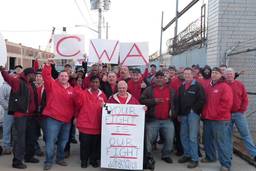Is abortion no longer taboo in the labor movement?
Over the weekend, the Wisconsin AFL CIO held a rally with Planned Parenthood. The two organizations stood in solidarity, opposing Gov. Scott Walker’s right-wing budget and unionbusting.
It might seem unusual that a labor federation which traditionally has shied away from such social issues would be willing to stand in solidarity with the hot button social issue of abortion. Many union members are social conservatives. Last year, my colleague Roger Bybee pointed out that the AFL-CIO refused to take a position on the Stupak amendment to the Affordable Health Care for America Act - the healthcare reform bill negotiated last year - which restricts women from using health insurance plans toward the cost of abortions.
So why, all of sudden, was the Wisconsin AFL-CIO standing strong in support of reproductive rights?
“As we stood up to the right-wing assault on working families, you could always see as you looked out, no matter the size of the crowd In the protests, no matter the size of the crowd, whether it be 1,000 or 20,000 or 100,000, you could always see the pink signs saying, “I stand with Planned Parenthood,” said Wisconsin AFL CIO President Phil Neuenfeld. “It’s about standing together, it’s about coming together to fight for our rights as workers and middle-class citizens.”
As right-wing attacks on unionism and social programs intensify, we are seeing new alliances emerge between progressive groups that normally shun each other.
The labor movement, at its core, is about class struggle - the working class overcoming the power of the owning class in order to take control over their own lives. For women, class struggle historically has centered on overcoming the oppression of men who want to have control over their lives.
Both struggles are about power and determination over one’s own life. The labor movement cannot advocate for economic self-determination without challenging the status quo for those who cannot determine their own lives due to issues related to gender, race, sexual orientation, disability etc. When we advocate for workers having control over their lives in the workplace without fighting for women to have control over their personal lives, it can make women feel like junior partners in the labor movement.
For lower-income working women, the ability to pay for an abortion is often a very important issue. Had the issue been banning insurance coverage for colonoscopies, a procedure that mostly affects men, the AFL-CIO would likely have been up in arms.
Indeed, the AFL CIO is the largest member-based organization for women in the United States, as Karen Nausbamm, now director of the AFL-CIO’s Working America, was fond of pointing out when she was head of out of its women’s department. In fact, the AFL-CIO comprises about 6 million dues-paying women who represent 45 percent of the organization’s membership.
By 2020, women will constitute the majority of union members. Despite women representing nearly half of the AFL CIO’s membership, the executive council of the AFL-CIO is 80 percent male. Often, women’s issues like reproductive health and rights are ignored.
With both groups now under attack, perhaps the AFL-CIO is finally beginning to realize the important of women to the labor movement. If we wish to build a vibrant movement that advocates for workers having control over their own lives, we must advocate for women having control over their lives. It’s exciting to see steps being taken to correct this problem in Wisconsin, ground zero of the rebirth of the labor movement.








